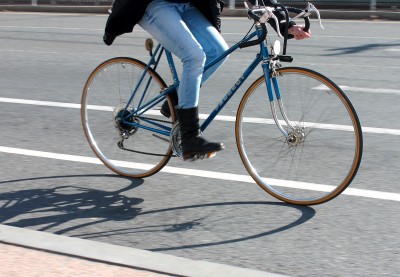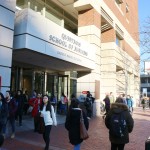
The City of Boston will construct new bike lanes on Commonwealth Avenue to provide a stress-free environment for the bicyclists, said Boston Transportation Department Deputy Commissioner James Gillooly. The project is expected to start this summer and be completed by 2018, he said.
The new bike lane will be installed between the Boston University Bridge and Packard’s Corner, and it will also consist of two main improvements that protect cyclists from drivers, Gillooly said.
The first improvement includes a 6-foot-wide bike track between two curbs along the road. One curb will separate biking space from the sidewalk, and the other will contain a 3-foot buffer separating the bicyclists from moving vehicles, Gillooly said.
The second improvement focuses specifically on intersections, where the bicycle lane will be closer to the sidewalk so that bicyclists and drivers are further away from one another, Gillooly explained.
“Imagine today you are on a bicycle, you are stopped at a red light and you’re right next to a delivery truck,” Gillooly said. “Then the light changes and you want to go straight, but the truck wants to turn right. You’re in an awkward situation as a bicyclist, because the truck driver might not see you and you might not realize the truck is about to change direction and turn right.”
The proposed improvements will protect cyclists from being blocked by doors opened by motor vehicle drivers.
“We’ve protected them as they go through the intersections by creating that widened space and a much better visibility of one to the other,” Gillooly said.
The construction will also bring new general upgrades to the sidewalks and roads of Commonwealth Avenue, Gillooly said.
“You’ll wind up with new pavement, new sidewalks, new street lights, new traffic signals, new bus stops and a complete upgrade to the accessibility of the walkways so that anybody who is mobility impaired should have a much better experience,” Gillooly said.
The construction project is part of Boston Mayor Martin Walsh’s $17 million initiative to improve Boston’s landscape that includes adding new street lighting, repaving streets and incorporating new street furniture, according to a March 24, 2015 press release. The project was initially scheduled to commence in spring 2016 and to be completed in fall 2017, the release stated.
LivableStreets Executive Director Jackie DeWolfe wrote in an email that bikers in the city are excited for the upcoming construction, calling it a big victory for the 100,000 people who travel on Commonwealth Avenue.
BU Police Department’s Deputy Director of Public Safety Scott Paré said he is hopeful the project will have a positive effect on BU students, though he warned bikers to remain cautious and follow the rules of the road.
“Sometimes [a] bike lane gives some of the bicyclists a little too much courage and they forget that they are also sharing the road with cars and pedestrians,” Paré said. “They need to pay a lot of attention to their surroundings and they just can’t feel that that a bike lane is impenetrable.”
Several students said new bike lanes will make Commonwealth Avenue a safer place for bikers, while pedestrians should continue to be mindful of the road and regulations.
Benjamin Hadar, a senior in the Questrom School of Business, said he experienced barrier-protected bike lanes while in Amsterdam, so he is happy Boston is adapting bike improvements that exist in other countries.
“Although BU and Boston have slowly added measures to promote and protect bikers [by] painting the roads, rent-bikes, etcetera, it would be a huge step forward to implement real safety structures and separate bike lanes,” Hadar said.
Garen Kroshian, a senior in the Sargent College of Health and Rehabilitation Sciences, said the new bike lanes will lower the fear of riding bikes on Commonwealth Avenue.
“Commonwealth Avenue is a scary place to bike for some people because of all the factors you need to consider: cars, buses, pedestrians and the T,” Kroshian said. “Because of the increase in safety [after construction], people will definitely feel more comfortable riding bikes on Commonwealth Avenue.”
Chelsey Chachoute, a sophomore in the College of Arts and Sciences, said after the construction, she will maintain the same mentality as a pedestrian.
“I still feel as though I need to be cautious because bikers drive really fast and sometimes they’re not as prudent as they should be,” Chachoute said. “I’ll still be looking out and being careful as I cross the street.”
A previous version of this story presented LivableStreets Executive Director Jackie DeWolfe’s saying “100,000 bikers who travel on Commonwealth Avenue,” instead of “100,000 people who travel on Commonwealth Avenue.” This correction is reflected in the story above.














